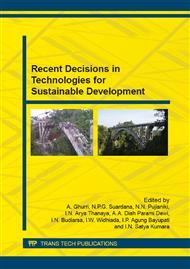p.289
p.294
p.300
p.309
p.313
p.319
p.325
p.331
p.337
Buckling Analysis on Pechiko Field of Fixed Offshore Platform in Makassar Strait
Abstract:
One of the most important criterion in the design of fixed offshore platform is to have strength from applied loads which is acting perpendicular to jacket leg section such as axial compression.The axial compressive load acts vertically downward to jacket legs and the deformation on the jacket legs in horizontal direction due to this load is called buckling. In the present study, buckling analysis on pechiko field of fixed offshore platform is performed using Finite Element Analysis (FEA). The fixed jacket platform namely tripod and tetrapod are taken as the object of the analysis. Only the axial compressive load is used in the analysis and the boundary conditions are assumed to be fixed both tripod and tetrapod at the bottom seabed. As a fundamental case, buckling analysis is carried out in plane-section (2D analysis), then the result obtained by FE analysis is compared with the analytical solution.It is found that the result obtained by FE analysis for the critical buckling load is in good agreement with the analytical solution, and the applicability of FE analysis is further used to investigate the deformation of 3D model.
Info:
Periodical:
Pages:
313-318
Citation:
Online since:
July 2015
Authors:
Price:
Сopyright:
© 2015 Trans Tech Publications Ltd. All Rights Reserved
Share:
Citation:


